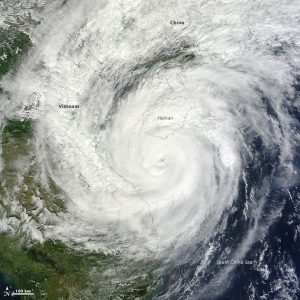20 November 2018
Pacific Ocean typhoons could be intensifying more than previously projected
Posted by Sandra Ortellado
By Sandra Ortellado
Changes to the uppermost layer of Earth’s oceans due to rising temperatures are likely causing an increase in intense Pacific Ocean typhoons, suggesting strong typhoons may occur more frequently than scientists project in the coming decades, according to new research.
The surface layer of the ocean, known as the ocean mixed layer, is approximately 200 meters (656 feet) deep on average. This layer is constantly exchanging gases with the atmosphere and experiencing mixing caused by winds, heat transfer, evaporation and changes in salinity.
Intense typhoons, like 2013’s Super Typhoon Haiyan, are classified based on high wind speeds, often of 130 mph or more. Typhoon Haiyan was one of the strongest tropical cyclones ever recorded, and scientists have noticed an increase in the proportion of intense typhoons occurring each season in the Pacific Ocean since the 1980s but have not been able to explain why.
A new study published in Earth’s Future, a journal of the American Geophysical Union, finds the ocean mixed layer deepened along tropical cyclone tracks by 1.7–2.0 meters from 2002-2015, while other factors changed only marginally. The authors conclude this deepening could be responsible for the uptick in intense typhoons from 1980 to 2015, and they project the increase of intense typhoons will continue at a greater rate than previously projected in the coming decades.
Understanding how climate variability within a climate system contributes to the observed increase in the proportion of intense typhoons helps scientists understand the hazards posed by devastating storms in the north Pacific Ocean, especially as the ocean and atmosphere continue to warm, according to the researchers.
“In the context of global warming, it’s important to know how the ocean responds to global warming, which factors contribute, and how that changes the structure of the ocean,” said Liguang Wu, lead author of the study and professor at Nanjing University of Information Science and Technology in Nanjing, China. “We need to be aware of how conditions are changing around us in order to prepare.”

A combined image of clouds and sea surface temperatures in the Atlantic on August 27, 1998, which shows Hurricane Bonnie over the East Coast of the United States and the cool water track that Bonnie left in its wake. Ocean surface cooling is a function of the ocean mixed layer depth, according to the new study.
Credit: NASA Scientific Visualization Studio
Why are typhoons becoming more intense?
Scientists have been studying the changes in typhoon intensity over the past several decades, but the reasons for the increase in typhoon intensity is still a subject of controversy, according to Wu.
In the new study, Wu and his team examined the contributions of various factors controlling typhoon intensity change, such as sea surface temperatures, the temperature of outward flowing air and water, ocean mixed layer depth, and vertical wind shear, as well as shifts in the tropical cyclone tracks. They used computer simulations to compare each factor with observed tropical cyclone intensities in the western North Pacific basin for each year from 1980-2015.
After quantifying the contribution of each environmental factor to tropical cyclone intensity, they determined that the increase in the proportion of intense typhoons was largely due to a deepening of the ocean mixed layer. This deepening is in turn caused by variations in ocean and atmospheric conditions.
The deepening of the ocean mixed layer is just one of many substantial changes to atmospheric and ocean circulations that have occurred in the western North Pacific since 2000 as a result of climate change, according to the researchers. Deepening of the ocean mixed layer is likely the major reason for the sudden increase in the proportion of intense typhoons in 2001, Wu said.
Because previous studies have not accounted for ocean mixed layer depth in their projections, the authors conclude that future typhoons in the North Pacific may be increasingly intense, and to an even greater degree than previously thought.
“Previous studies have focused mainly on the role of sea surface temperature in changing typhoon intensity,” Wu said. “But they did not account for ocean mixed layer depth as we have, which is why we think that those projections might have underestimated the increase in typhoon intensity.”











 GeoSpace is a blog on Earth and space science, managed by AGU’s Public Information staff. The blog features posts by AGU writers and guest contributors on all sorts of relevant science topics, but with a focus on new research and geo and space sciences-related stories that are currently in the news.
GeoSpace is a blog on Earth and space science, managed by AGU’s Public Information staff. The blog features posts by AGU writers and guest contributors on all sorts of relevant science topics, but with a focus on new research and geo and space sciences-related stories that are currently in the news.